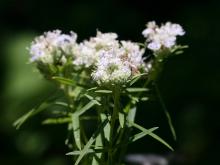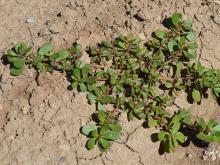Wildflowers, Grasses and Other Nonwoody Plants
Media

Species Types
Scientific Name
Monarda bradburiana (sometimes M. russeliana)
Description
Also called horsemint and wild bergamot, Bradbury beebalm is a showy, fragrant plant that is a favorite of native plant gardeners. It’s also a favorite of Missouri’s butterflies!
Media

Species Types
Scientific Name
Valerianella radiata
Description
At first glance, you might overlook corn salad, except for the large colonies it often forms. The young leaves can be eaten as a salad green, hence the name.
Media

Species Types
Scientific Name
Cardamine concatenata (formerly Dentaria laciniata)
Description
Toothwort is a member of the mustard family that blooms March–May in wooded slopes and valleys. The sharply toothed, deeply lobed leaves are distinctive. The bright white, 4-petaled flowers shine at forest visitors.
Media

Species Types
Scientific Name
Pycnanthemum tenuifolium
Description
Slender mountain mint has smooth, square stems, opposite, narrow leaves, and dense heads of 2-lipped white (or lavender) flowers. Aromatic and minty, it can be grown at home in the herb garden, and its leaves used for seasoning food.
Media

Species Types
Scientific Name
Helianthus annuus
Description
Whether you see the wild form or any of the many cultivated varieties, this poster child of the sunflower family cultivates its own sunny impression. Common sunflower is also the state flower of Kansas.
Media

Species Types
Scientific Name
Viola pubescens (formerly V. pensylvanica)
Description
The yellow violet is Missouri's only all-yellow violet. This native wildflower is less common than violet violets. Look for it in low woods, rich slopes, and wooded floodplains.
Media

Species Types
Scientific Name
Viola bicolor
Description
Johnny-jump-up is a flat-faced violet whose small flowers are a washed-out blue or violet with a very light yellow or white center. Look for it in fields, meadows, glades, rights-of-way, disturbed sites, and possibly your front lawn.
Media

Species Types
Scientific Name
Chenopodium album
Description
Lamb’s quarters won’t win any beauty contests for its flowers, but it merits an award for being both a common garden weed as well as a nutritious leafy green valued around the world.
Media

Species Types
Scientific Name
Portulaca oleracea
Description
Purslane can be an aggressive pest in gardens and is one of the worst agricultural weeds in the world. Meanwhile, it’s also a favorite wild vegetable served cooked or raw, and many people cultivate it.
Media

Species Types
Scientific Name
Viola spp.
Description
Violets, as a group, are fairly easy to identify, with their colorful five-petaled “faces” so welcome in springtime. Missouri has 17 species, and some are confusingly similar. This page introduces them as a group.
See Also
About Wildflowers, Grasses and Other Nonwoody Plants in Missouri
A very simple way of thinking about the green world is to divide the vascular plants into two groups: woody and nonwoody (or herbaceous). But this is an artificial division; many plant families include some species that are woody and some that are not. The diversity of nonwoody vascular plants is staggering! Think of all the ferns, grasses, sedges, lilies, peas, sunflowers, nightshades, milkweeds, mustards, mints, and mallows — weeds and wildflowers — and many more!





















